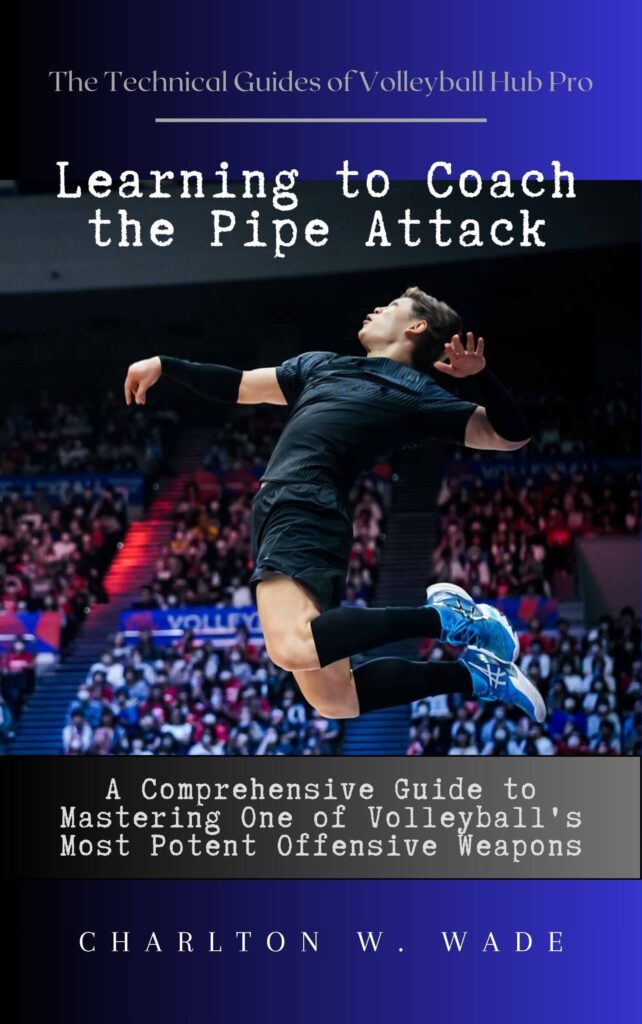
The Pipe Attack Uncovered
The pipe attack, also known as the back-row attack or BIC (back-row inter cross court), is an offensive technique that has become a staple in elite volleyball strategies. By capitalizing on the unique positioning allowed for back-row players, the pipe turns a traditional three-attacker front into a four-attacker assault, challenging opposing defenses in new ways.
At its core, the pipe involves a back-row hitter, typically the opposite or opposite-hitter, making a angled trajectory cross-court run from their starting position to attack a high, driven set near the antenna. When timed and executed properly, the pipe can catch defenses flat-footed, exploiting seams between blockers and compromised court positioning. The element of surprise and deceptive nature are what make this particular attack so potent.
The key advantages that have propelled the pipe’s surge in prominence include:
- Increasing offensive variability by adding another constant attacker
- Forcing defensive adjustments and more court coverage by opponents
- Facing fewer or compromised blockers on the attack
- Shot angles and speed create lower offensive chances for the defense
- Psychological impact of a looming, unconventional attack
While elements of the pipe have existed for decades, its widespread adoption and advanced offensive scheming around it are relatively modern developments. As the sport has evolved to prioritize athletics and a quicker attack tempo, focusing on back-row attacks like the pipe has become essential for internationally competitive teams.
Several iconic players have etched their names in history as pipe attacking specialists. Cuban national Wilfredo León is widely regarded as one of the most prolific operators of the pipe in the modern era. His ability to runway spike from virtually anywhere on the court and split-step approach make him a constant offensive threat. Other names like the agile Klemen Čebulj of Slovenia and deceptive Alessandro Michieletto of Italy have propelled the shot’s popularity with their crafty implementations.
When scheming on offense, coaches carefully evaluate the ideal situations to unleash their pipe attackers:
- On perfect passes that allow a high, attackable set
- Versus undersized or out-of-system opposing blockers
- As a change-of-pace attack mixed into the offensive flow
- From running specific rotations and positional advantages
By catching defenses leaning the wrong way or struggling to make adjustments, pipe attackers can become virtually unstoppable, acting as a highly efficient point-scoring weapon. As the shot continues evolving, the pipe attack is cementing itself as a required component of any championship-caliber squad.
Technique Breakdown: The Three-Step Approach
At the heart of executing a commanding pipe attack is mastering the three-step approach – the fundamental movement pattern that generates the power, height and swing mechanics for the hitter. While sharing similarities with traditional front-row spiking, the pipe’s unique angles and timing nuances require specific adjustments.
The first step, referred to as the stride step or directional step, involves taking a elongated step with the hitter’s outside foot (left for right-handed, right for left-handed). This diagonal crossover movement aligns the hitter’s body and approach with the intended pipe trajectory. Keeping the arms extended and shoulders square to the net is crucial during this load-up phase.
The second step is known as the accelerating step or crossover step. The hitter’s inside foot now takes a large step, powerfully driving their momentum towards the net. Synchronizing this motion with an explosive arm swing behind the body generates the majority of the approach’s force. Hip and shoulder separation create the required torque for an energized shoulder turn over the hitting shoulder.
The final step is the\restep or jump stride, where the hitter re-plants their outside foot. This grounding mechanism allows the quick transference of horizontal velocity into vertical jump force. As the outside arm naturally unwinds up and over, the hitting shoulder should be set in its loaded position, ready to unleash the pipe swing at its apex above the net.
Proper timing is vital. Many coaches instruct hitters to strike the left foot plant simultaneous with when the setter touches the ball (“setter plays, you left footplays”). Other envision the right foot landing split seconds after the set is released to slightly delay the attack window. While timing preferences vary between teams and hitters, the cadence should remain consistent.
To groove these biomechanical sequences, hitters utilize an extensive drill progression beginning from a stationary start position. Approaches without a ball establish the movement patterns before adding the jump, swing and coach-tossed ball feeds. Tossing pipes directly at net level accelerates the speed and jumping requirements. Finally,live-hitting off-speed sets from the setter integrates the approach with reading and reacting to ball speed variances.
Developing a fluid, effortless and adjustable three-step pipeline is essential for any pipe attacker. The position demands explosiveness combined with body control – transforming the approach into a graceful attack opportunity. With disciplined technique and thousands ofcarefully-grooved reps, the pipe swing can be wielded as a deadly offensive weapon. Copy
Setting Up for Success: The Setter’s Role
While the pipe hitter garners much of the attention, the setter acts as the orchestra conductor for this offensive symphony. Their ability to read developing plays, make split-second decisions, and precisely locate the ball is what elevates good pipe attacks into great ones. The slightest miscalculation can render the pipe easily defensible or outright ineffective.
Reading the opponent’s defense and anticipating their movements is paramount for the setter. They must instinctively recognize rotational holes, over-pursuits or defensive misalignments that create opportunistic pipe windows before the ball is even passed their way. Heightened court awareness allows them to pull the string on calling pipe attempts when situationally advantageous.
Once the offensive choice is made, ball placement becomes critical. There are three primary pipe set locations that accomplish different objectives:
Front Pipe Sets are located tight to the antenna, often just inside the hitter’s approach path. This compact set forces the hitter to meet the ball on an upward-traveling window for an aggressive, stallings-iltered pipe slam. Generating topspin becomes easier, but the passing lane is also slightly narrower.
Zone Pipes are set slightly deeper into the hitting box, around the opposite’s typical front-row attack position. This adds transitional time for the hitter compared to the front pipe while widening the potential angle for cross-court or line pipe attempts. However, the deeper dish makes driving topspin trajectory more difficult.
Hang or Hut Pipes are even more set-ter set, forcing the hitter to detour behind their approach line. While creating more defensive scrambling time, these pipe distance require precision control for both hitter and setter while minimizing the hitter’s forward momentum.
Disguising the pipe set through deception and holding visual cues is also critical. Elite setters master a deadpan face, keeping their head, shoulder and hand positioning identical no matter where the set is dispensed. This misdirection buys the hitters extra fractions of a second before defenses can read and react accordingly.
Timing and ball speeds represent another variable setters manipulate. Altering the tempos between first, second and third opportunities impacts both the hitters and how defenses must compensate. An off-speed pipe traveling on an arcing trajectory stands in contrast to the traditionally hard-driven straight set.
By blending innate decision-making, technical precision and deceptive skills, the setter can fluctuate between various pipe looks, locations and speeds to creatively disrupt opposing defenses. When their symbiotic connection with the pipe hitter is operating at peak efficiency, setter delivery makes the difference between a good and great pipe attack. Copy
Spiking Strategies for the Pipe Attacker
With the low defensive chances to properly dig or control a well-struck pipe attack, the hitter maintains a decided advantage when strategically selecting their spike approach. Effectively dissecting the court’s scoring zones and varying shot types keeps defenses perpetually off-balance.
Establishing a consistent pipeline to the deep corners should be the pipe hitter’s primary objective. These cross-court line angles are usually left vulnerable by shifting block formations and scrambling defenders. Ripping a topspin-heavy pipe with laser-like precision and pace to the far corners maximizes the offensive’s point-scoring efficiency from low-risk defensive confrontations.
However, elite pipe attackers possess a full arsenal beyond just corner-targeting power spikes. Deceptively tipping or rolling the pipe shot over or around a drawn-in block can produce easy winners when the defense overcompensates. This change-of-pace weaponry is most effective when incorporated intermittently after establishing firm hitters’ tendencies.
Shot placement along the offensive lines also comes into play for pipe hitters. Seam-splitting pipes aimed directly at the backline defensive positioning can pull diggers out of their ideal pursuing angles. Line-hugging pipes also open up Down-The-Line angled attempts if hitters can angle their approach run farther off the net.
Varying trajectories represents another dimension for the pipe attacker. A floating pipe lacking topspin spin holds its offensive court positioning longer, creating awkward defensive transitioning. Contrastingly, a pipe descending off a taller swing plane with aggressive topspin bite can skid unpredictably upon landing. Even mixing in tighter arcing line pipes that mouth the net cord can disrupt opposing blocking schemes.
In-game making adjustments based on how the opponent defense is digging or positioning is also key. If the pipe is getting consistently dug from certain areas of the court, transitioning to higher risk/higher reward cross-court attempts or even sliding line shots behind defenders can re-capture the hitters’ advantage.
The elite pipe attacker wields a multi-dimensional skillset capable of winning battles both technically and strategically. Adding variety to their spike velocity, movement, spin, and targeting point is what separates good pipe hitters from great ones who can single-handedly dismantle a defense. Copy
Offensive Systems Incorporating the Pipe
While the pipe attack itself represents a powerful offensive weapon, constructing a comprehensive system and rotational strategy around its deployment unlocks its full potential. Scheming creative overload formations that create advantageous matchups is where coaching strategy comes into play.
On the most basic level, teams can opt to run a 6-2 or 5-1 offensive system incorporating the pipe attack. In a 6-2, both setters alternate between facilitating the front row and participating as a back-row attacker themselves when rotating into the pipe position. Conversely, 5-1 offenses feature a designated setter who triggers the pipe out of their permanent back row spot.
More advanced deployments seek to tilt the offensive balance in their favor through strategic positioning and overloading formations:
Tandem Middle and Pipe attacks from the same side overwhelm defenses trying to account for two simultaneous hitters from different trajectories. Releasing the front row attack opportunity opens up cleaner pipe angles.
Rotations stacking opposite hitters in adjacent front/back row spots can make defenses misjudge which attacker is the actual pipe threat on any given possession.
Out-of-system pipe pursuit attempts take advantage of over-shifting defenses, sending back row hitters from unexpected starting points on the court’s opposite side to exploit vacated defensive responsibility.
Integrating utility hitters who can pi Sustge between hitting front row and back row creates formational versatility and additional defensive guesswork.
In the template offenses, setters facilitate predictable attacks from each position. In modern schemes, they are empowered to read and decide which multitude of options provides the best scoring chance on each particular sequence based on rotational advantages.
Offensive coaches implement corresponding defensive gameplans, tasking specific players and positions to properly cover pipe responsibility based on all these shifting attacks and movements. Making pre-snap read adjustments on coverages, sprawling out to recuperate lost defensive court positioning, and rotating help responsibilities become paramount.
The pipe is no longer just an occasional changeup look, but rather the catalyst for an entire progressive offensive strategy aiming to manufacture as many mismatches and unfavorable guessing situations for the opposing defenses as possible. Designing cohesive and dynamic systems centered around the pipe has become requisite for top international teams. Copy
Coordinating with Middles and Passers
While the setter and pipe hitter are the featured performers, successfully executing a dynamic pipe attack requires comprehensive synchronization between all members of the offensive cast. Developing interconnected chemistry and establishing clear communication cues integrates each supporting role into a cohesive unit.
The back-row pipe hitter’s precursory movements actually originate from the middle blocker(s)’ initial action. Whether scheming a tandem middle and pipe combination or simply disguising the attack starting point, the middle blockers dictatedefensive shifting and open pivotal seams.
Verbal and visual cues between middles and the setter establish this opening act. Coded words or hand signals convey their intent to pull the defense one way before triggering the backdoor pipe set in the opposite direction. Deceptively framing their approach steps also manipulates pursuit angles.
As the sequence develops, pipe hitters must be in seamless visual connectivity with their setters. Constant eye communication and body language — even mid-approach — facilitates the synchronization needed to mesh the setter’s ball trajectory with the hitter’s pipeline. A slight nod or target-pointing can confirm offensive tactics.
From the service line, the initial pass’s location initiates the entire offensive chain reaction. Passers Understanding their specific responsibilities in dictating the angle and distance of every pipe attempt is vital. Subtle differences in ball positioning can drastically alter the pipe set point and running lanes available to the hitter.
Communication between these three principals remains constant and fluid throughout the entire possession. Developing their timing, relationships and overall court awareness as an interconnected triad elevates the pipe game to its highest level.
Away from live competitions, pipe-running meetings and film sessions reinforce everyone’s roles and Visual cue recognition. Repetitively grooving the approach timing and communication sequences through meditative drill work also solidifies chemistry between the principals.
The brilliance of an unstoppable pipe attack emerges from the collective cohesion of multiple parts rather than just elite individuals operating independently. When setters, hitters, middles and passers synchronize as a united offensive machine, the pipe becomes an overwhelming offensive force. Copy
Defending Against the Potent Pipe
On the defensive side of the net, the pipe attack represents one of volleyball’s most daunting challenges. With proper execution, the element of surprise and unique angles make this an incredibly difficult offensive weapon to counteract. However, focused scouting, disciplined positioning, and adjustable gameplans can mitigate the pipe’s effectiveness.
The first key for defenders is simply recognizing and anticipating when a pipe attempt is being set into motion. Educated roster awareness provides the initial trigger – understanding which opposing players are designated pipe hitters in certain rotations. From there, experienced defenders can detect subtle offensive cues that signal an impending pipe set based on spacing, footwork patterns, and the ball’s traveled trajectory off the pass.
As soon as a pipe becomes evident, defensive focus must quickly shift to rapidly reforming the block’s integrity. Effective communication between the floor defense and front players is critical for executing this transition smoothly. Predetermined verbal or hand-signal cueing facilitates shuffling feet and bodies into the proper blocking configuration to attempt deterring the angled cross-court attack before it’s unleashed.
Various block philosophies can be employed depending on the opposing team’s pipe tendencies and personnel. Funnel blocking aims to force pipes down prescribed defensive channels by strategically leaving one line open. Aggressively shifting the full block commit maximum resources to deterring the attack source. Or a more conservative gap-coverage approach maintains basic block positioning while focusing on digger coverage of the seams.
Positioning and shading the back court defenders is equally vital when dealing with prolific pipe teams. Rotating help pursuit responsibilities relays whichdiggers and zones take priority for anticipating and pursuing pipe attempts from different hitters and sets. Deception awareness – recognizing setters’ visual indicators for pipe sets – allows defenders to jump-start their reactions earlier.
Serving and transition strategies can also make pipes more difficult to consistently execute for the offense. Disrupting established offensive systems and rotations through targeted serving zones prevents pipe hitters from occupying their preferred starting points. Transitioning into defensive rotations and positioning more rapidly after side-outs forces offenses to terminate prematurely or default into higher-risk pipe attempts.
While there is no definitively solving the pipe given its multitude of versatile implementations, proactive scouting and a sound defensive gameplan can begin limiting its impact. Removing any possible element of surprise and channeling the offense into suboptimal situations is the blueprint for suppressing elite pipe teams.
The Guides of Volleyball Hub Pro
If you’re looking to delve deeper into this topic, I highly recommend reading the following books authored by our team:













